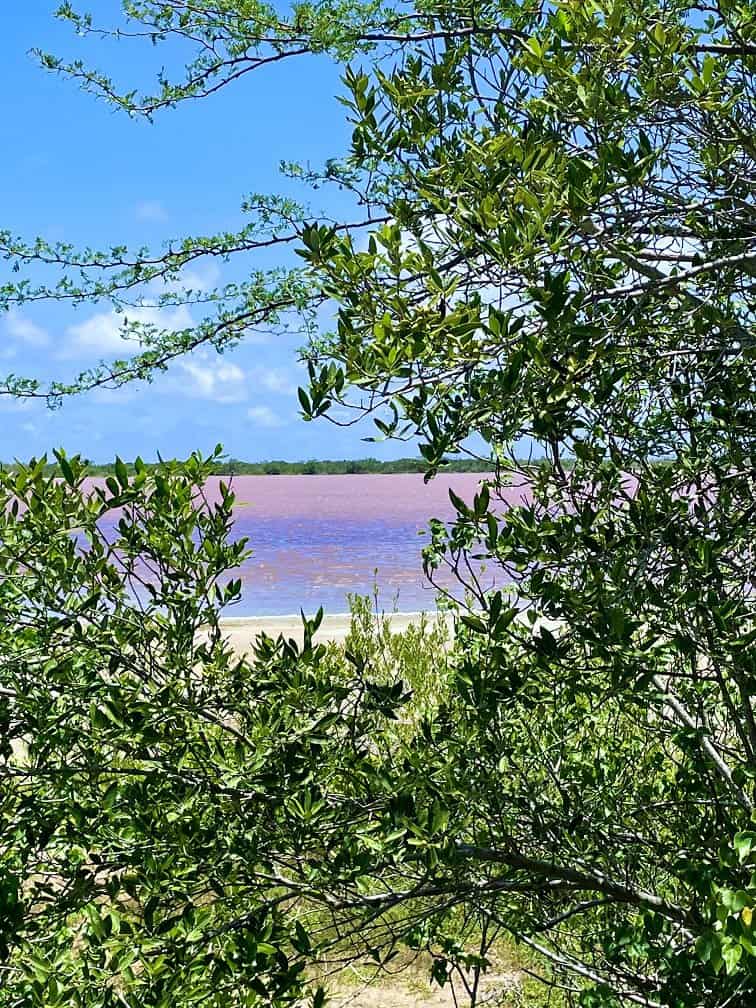The Salt Flats of Puerto Rico – Cabo Rojo, Las Salinas
I bet you did not know there are pink salt flats in Puerto Rico! You can find them in Cabo Rojo, on the island’s southwest side. The pink flats have other names, “Cabo Rojo Salt Flats” or “Cabo Rojo Las Salinas.” I just got back for Puerto Rico, and one of the sites we went to explore is The Salt Flats of Puerto Rico.
Not necessarily a day out per se. But definitely, a delight to see! This is my first time seeing pink lakes or “pink salt flats.” I was astonished. With the color pink sprinkled throughout the water, the color pink becomes capricious, softening the horizon. The Cabo Rojo Salt Flats, or Las Salinas, is a beautiful destination in Puerto Rico. The pink water ponds in Las Salinas are complete with bright blue skies and turquoise oceans, which make the experience quite surreal.

This post may contain affiliate links. Please read our disclosure and privacy policy for more information.
What Are Pink Salt Flats?
Salt flats are characterized by pink water due to their salinity. Algae, bacteria, salt, and water cause the pink hue. Watercolor in salt flats is mainly caused by algae called Dunaliella salina. Even though it belongs to the algae family, it’s loaded with carotenoids – pigments that give orange and red fruits and vegetables their color.
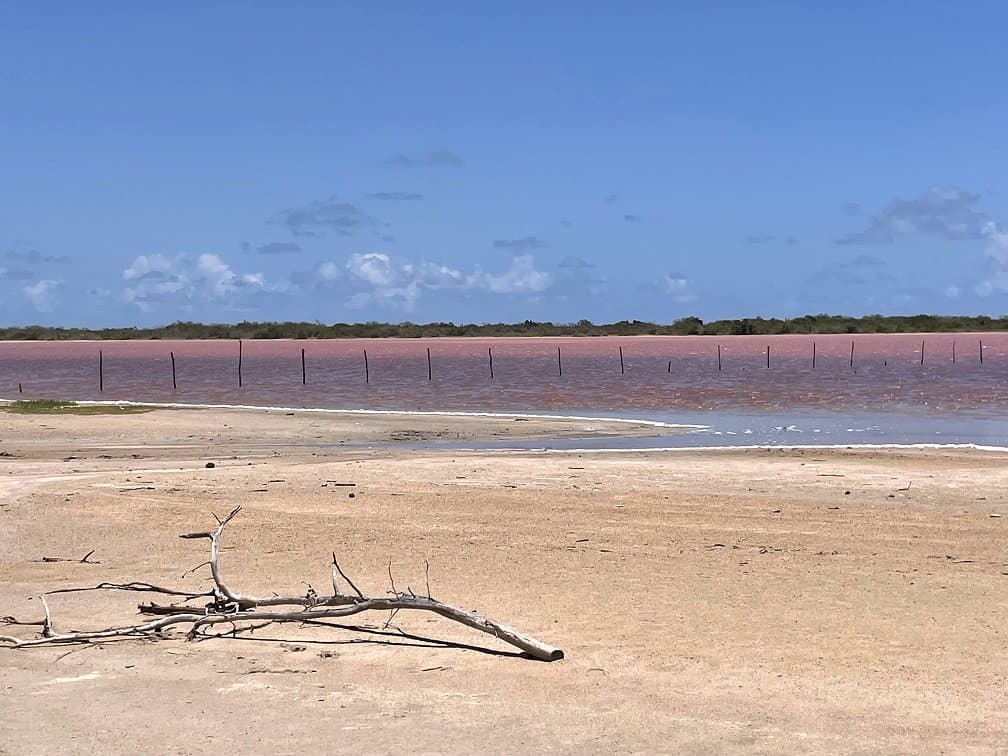
Where Are the Pink Salt Flats of Puerto Rico?
Pink lakes can be found on PR-301 south of Cabo Rojo. Their location is close to several major cities, such as Mayaguez, Ponce, and Aguadilla.
Getting To Cabo Rojo – Las Salinas
The best way to access Cabo Rojo, Las Salinas, is to rent a car. There is no public transportation outside the metro areas; even then, routes are limited. Drive carefully. With other cars driving quickly, even when turning blind corners, the roads can be hazardous and narrow. Some people caution visitors about Carjackings. I highly doubt you will experience this unless you travel there at night, which would be pointless.
The Roads into Cabo Rojo – Las Salinas
You need to know that the main roads leading into the Pink Salt Flats are in decent condition. The minute you pass the observation tower, you will be driving on an unpredictable sand bed.
There are sections that you may not be able to cross. We could only make it halfway through because we were not in a four-wheel drive vehicle. And the water was flowing rapidly through some of the sections you needed to cross. Even with a four-wheel drive vehicle, you must assess the conditions carefully. Here is an example of what to expect:
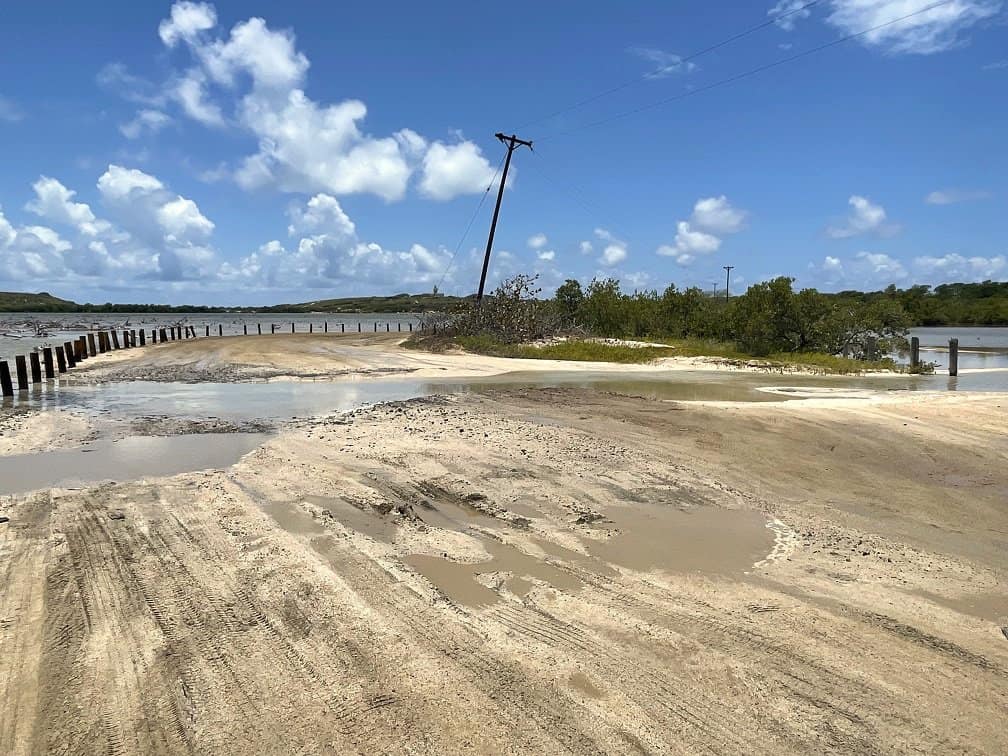
Viewing The Salt Flats of Puerto Rico
There are approximately 1,250 acres of salt flats at Cabo Rojo. Start your hike at the visitors’ center near the observation tower for panoramic views of the colorful salt flats.
Note: When we visited, the observation tower was closed.
Don’t despair if the observation tower is closed. You can still view the pink salt flats from various locations. All you need to do is drive around the area to view the salt flats. Then, you get to the entrance, park outside and walk down to the hypersaline lagoons.
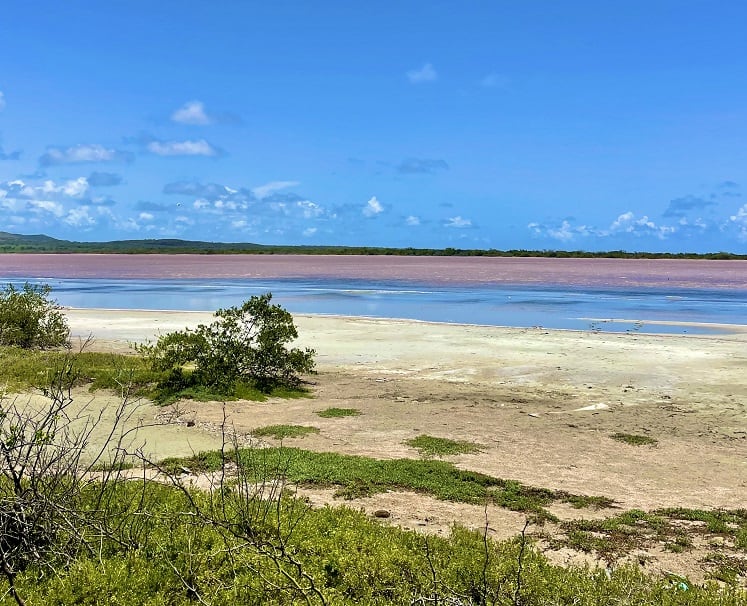
From bright pink to pale pink, the color of the water in the pond changes constantly depending on the concentration of salt. The views are spectacular, and it’s worth the trip for this reason alone. While at Cabo Rojo, you can walk the divide between the pink lakes. A sunny day is the best time to see the pink lakes’ vibrant pink hue, but you can see them all year round.
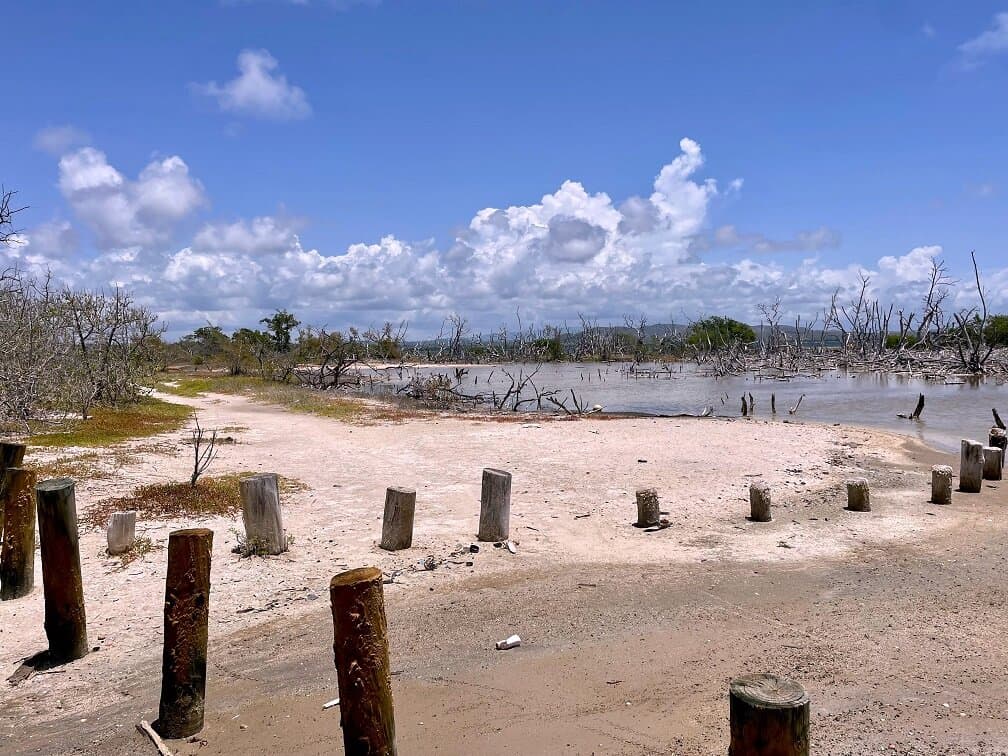
Currently, there are few regulations in place. You don’t need a guide or pay admission to enter; it’s free. You should take advantage of these salt flats while you can, as the openness of the salt flats is uncertain for the foreseeable future.

Salt flats in the area are not all pink. The coastline sports different shades, and you can stop along the way at any time. There is usually a cluster of parked cars across the street from the brightest point, not far after a large observation tower.
Bird Watching at The Salt Flats of Puerto Rico
The Pink Salt Flats is considered one of Puerto Rico’s best bird-watching locations. Given this, the area is officially a National Wildlife Refuge. Winter brings about 40,000 migrating birds to the area. The saline ponds have brine shrimp that serves as an excellent food source for birds.
Salt Production at Cabo Rojo Salt Flats
Cabo Rojo Salt Flats are historically significant. Salt mining is one of Puerto Rico’s oldest businesses. By 1493, the Indigenous Araucos and Tano were already extracting salt from the flats and had been doing so since 700 CE.
Spanish settlers exported salt and enslaved Indigenous populations to do the hard labor of raking up and cleaning the salt after arriving. Locals contested Spanish control, but they disapproved.
Salt Mining Today
Natural Resources Conservation Service (NRCS) funded a private landowner’s purchase of Cabo Rojo salt flats in 1999. Salt production was assessed to decide whether it should be a part of the Cabo Rojo National Wildlife Refuge.
Commercial enterprises must prove that they benefit species and habitats before operating within refuges. The salt production at the site created prime habitat for shorebirds as a by-product. Consequently, Empresas Padilla, Inc. receives a particular use permit. Padilla Enterprises pays to operate within Cabo Rojo, but their rent does not support the refuge. Cabo Rojo NWR does not receive the fees they pay to the USFWS. However, the company plays a vital role in maintaining the shorebird hotspot by managing water levels at the site. When you visit, you’ll see the salt production in the process.

There are currently five employees at Cabo Rojo. A much larger workforce would be required to operate the salt flats without Empresas Padilla’s collaboration. The area is co-managed by the Caborrojeño Pro Health and Environment Committee, which has defended the ecosystems of southwest Puerto Rico since 1990.
They currently receive hundreds of visitors to the Centro de Las Salinas de Cabo Rojo.
How is The Salt Made?
The salt is extracted using the sun to evaporate the seawater; that’s why they also call it solar salt.
- By connecting gates and canals, the nearby bay transfers seawater to a large pond called a hypersaline lagoon.
- As the water evaporates under the hot Caribbean sun for two or three months, its salinity increases.
- Cuajadoras or crystallizers are used to pump salt water. Essentially, these are colossal cement pools.
- As the water evaporates, salt will crystallize.
- In the hypersaline lagoon, water is pumped again to the pond. Repeating this process until a significant amount of salt is accumulated is necessary. It takes about two to three months to complete this process.
- A pump removes the excess water when there is enough salt, leaving the crystals behind.
- Salt mounds are piled up and dried in the open air before being bagged.
Los Morrillos Lighthouse
If you are lucky enough to drive over the entire salt flats, you can make it to Los Morrillos Lighthouse. At the southwest tip of Puerto Rico, the Cabo Rojo Lighthouse stands atop 200-foot limestone cliffs overlooking the Caribbean Sea.
Locals call it El Faro, the Cabo Rojo Lighthouse was built by the Spanish government in 1881 using the same design as the Fajardo and Arecibo lighthouses. Los Morrillos Lighthouse is just a little farther down Road 301. However, you can see the lighthouse in the background.
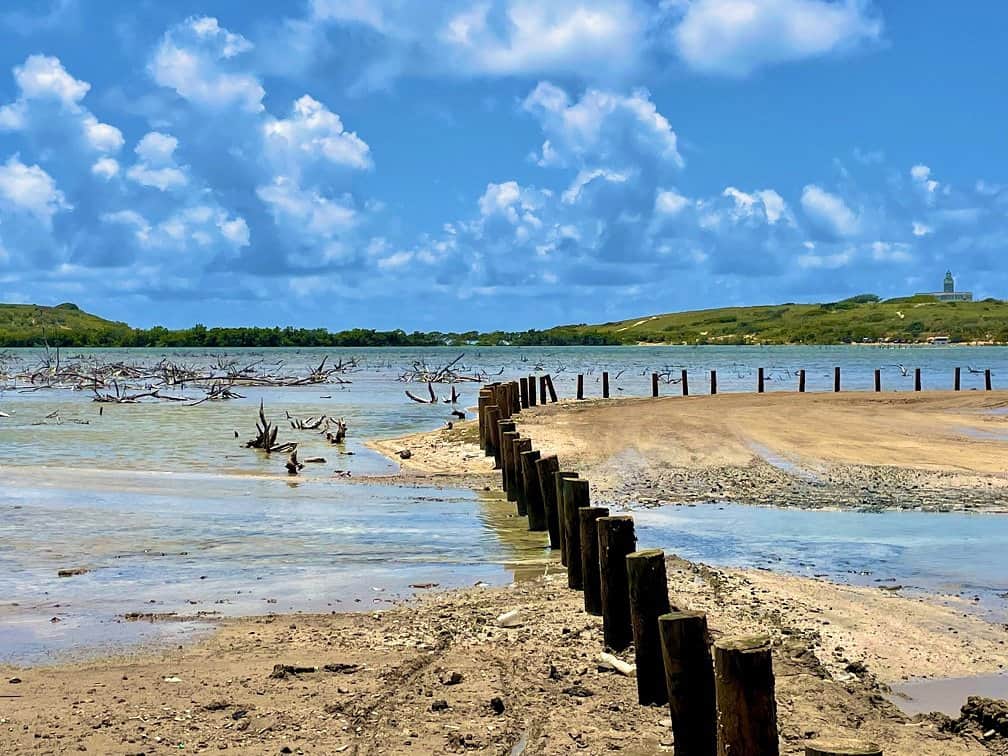
When Is the Best Time to Visit The Salt Flats of Puerto Rico?
There is no better time to visit Puerto Rico than November-April, when the weather is driest. It is a great time to visit in April and May once the winter crowds have dissipated. The weather is wetter and stormier from June to September.
Where To Stay In Cabo Rojo, Puerto Rico
Booking.comFAQs About The Salt Flats of Puerto Rico
Closing Thoughts
As mentioned above, visiting The Salt Flats of Puerto Rico, aka “Cabo Rojo Salt Flats” or “Cabo Rojo Las Salinas,” is not a day out. However, it’s more than worth your time. The carrying colors of pink mixed in with the hues of blue are any photographer’s dream. Instagram fanatics should have this place high on their list as the photo opportunities are abundant. Likewise, bird-watching enthusiasts will have a field day here observing the wildlife.
The real reason to visit is this historically significant site turned wildlife refuge that is still an active working salt mine. There are few places in the world where you’ll experience this wonder.
Looking for articles on navigating tropical islands? Start here:
- 6 Best Ways To Explore The Caribbean Islands
- Aguadilla Puerto Rico: The Complete Travel Guide
- Barbados’s Shipwrecks
- Bermuda Car Rentals – Why You Should Avoid Them
- Cuba – Yes, Americans can still travel To Cuba!
- Oasis of The Seas – The Amplified Version
- Turks and Caicos – Things To Do
We participate in the Amazon Services LLC Associates Program, an affiliate advertising program designed to provide a means for us to earn fees by linking to Amazon.com and affiliated sites.
Brit On The Move™ Travel Resources
Ready to book your next trip? Use these resources that work:
Was the flight canceled or delayed? Find out if you are eligible for compensation with AirHelp.
- Book your Hotel: Find the best prices; use Booking.com
- Find Apartment Rentals: You will find the best prices on apartment rentals with Booking.com’s Apartment Finder.
- Travel Insurance: Don’t leave home without it. View our suggestions to help you decide which travel insurance is for you: Travel Insurance Guide.
- Want to earn tons of points and make your next trip accessible? Check out our recommendations for Travel Credit Cards.
- Want To Take A Volunteer Vacation or a Working Holiday? Check out the complete guide to how here!
- Want to Shop For Travel Accessories? Check out our Travel Shop.
Need more help planning your trip? Visit our Resources Page, which highlights the great companies we use for traveling.
